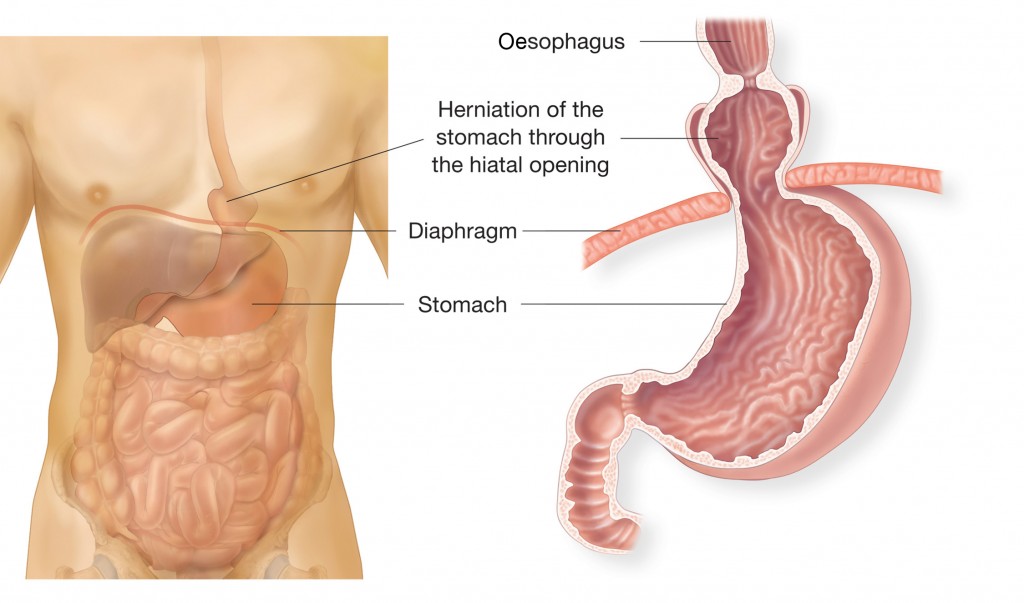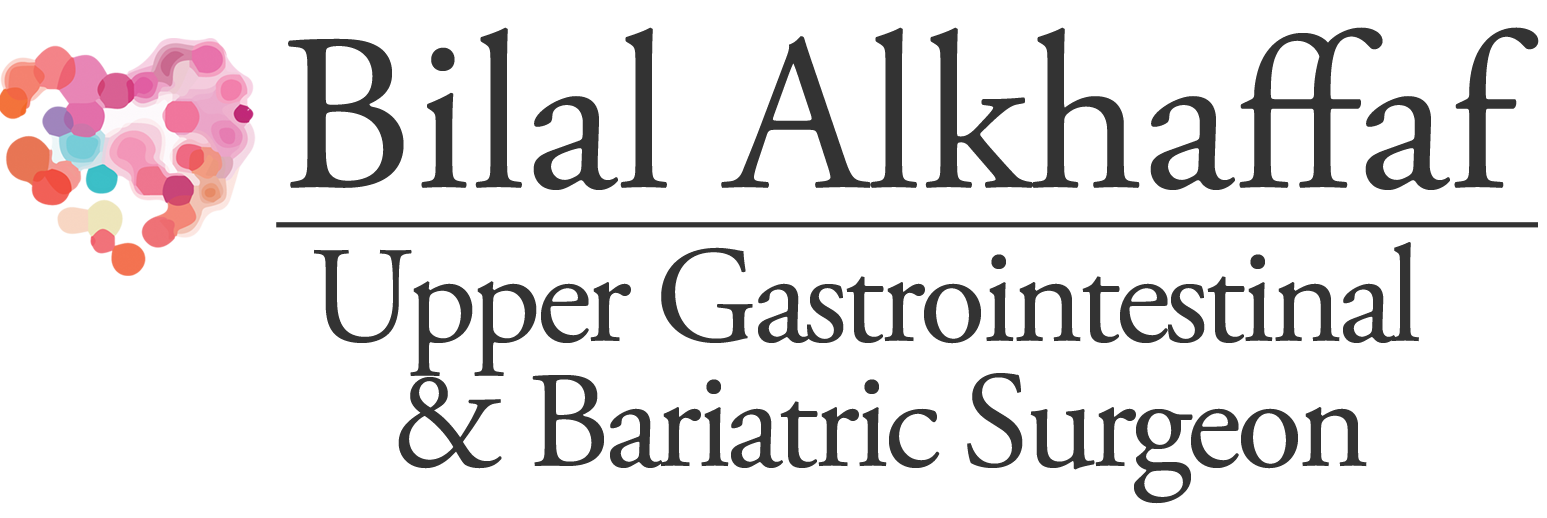Hiatus hernia is a common condition which under certain circumstances can have a significant impact on your quality of life, affecting what you can eat and impeding your ability to do simple things such as dining out with friends and family. Mr Alkhaffaf’s diligence in organising the correct investigations in combination with his advanced keyhole surgery techniques ensures that you have access to the most up-to-date treatments, personalised to your situation.
Common Questions About Hiatus Hernia
Q: What is a Hiatus Hernia?
The diaphragm is a flat muscle which divides the chest and abdomen. Normally, the food pipe (oesophagus) passes into your stomach through a hole in the diaphragm called the hiatus. Under certain conditions, this hole or hiatus can widen and the stomach which usually sits entirely in the abdomen can enter through this hiatus. This is a hiatus hernia. In severe cases, the entire stomach and other organs can also pass into the chest. 
Q: How Common are Hiatus Hernias?
Hiatus hernias are extremely common amongst the general population. It is thought that around 1 in 4 patients undergoing investigations for heartburn have a hiatus hernia.
Q: What Are the Symptoms?
Symptoms associated with a hiatus hernia depend on several factors. Some hiatus hernias cause no problems at all whilst others can severely impact on your quality of life. The size of the hiatus hernia is one of the biggest factors which can influence the symptoms you suffer from. These can include:
-Vomiting and regurgitation of food
-Breathing difficulties
In severe cases where most of the stomach and even other organs within the body pass through the hiatus hernia, you can suffer from severe pain and become acutely unwell. In this scenario, you should seek out immediate medical attention.
Q: What Causes a Hiatus Hernia?
The exact cause of hiatus hernias is sometimes difficult to ascertain but can be due to general weakening of the diaphragm muscle with age. We know that they are more common in patients who are over the age of 50 or in patients who are significantly overweight.
Q: How is a Hiatus Hernia Treated?
Sometimes a hiatus hernia can be diagnosed on a gastroscopy test whilst you are being investigated for other symptoms. If this is the case and your hiatus hernia is not causing any problems, then there is no treatment required.
If you are suffering from symptoms such acid reflux, then the first step is to investigate these thoroughly and then then to treat the symptoms. In severe cases where symptoms are either uncontrolled or the investigations suggest that simple treatment will likely be unsuccessful, then surgery can be considered.
Q: What Are The Surgical Options for a Hiatus Hernia?
Laparoscopic Fundoplication
The traditional procedure undertaken to treat a hiatus hernia is a called a ‘laparoscopic fundoplication’. This is a medical term for keyhole surgery which has three stages:
-The stomach is brought back down from the chest cavity to sit in its normal position in the abdomen.
-The gap through which the stomach passed (the hiatus) is repaired to stop the stomach from going back up into the chest
-The top of the stomach is wrapped around the bottom of the gullet (‘fundoplication’) to stop acid refluxing back into the gullet.
Because surgery is undertaken using a keyhole technique, you can usually be discharged from hospital within 24 hours of your operation. If you have a large hiatus hernia, then your stay in hospital may be longer. Most people are able to begin undertaking some light normal activities the following day. It takes around 7 to 10 days to recover from the incisions (longer if the hiatus hernia is large) and you will have to go on a special diet for 6 weeks afterwards.

Q: How Successful is Surgery for Acid Reflux?
Anti-reflux surgery is a well established treatment and as such there is a wealth of information on its long-term success. Advances in surgery such as keyhole (laparoscopic) techniques have significantly improved results after surgery. Approximately 9 out of 10 patients achieve long-term satisfaction following their surgery and would recommend it as a treatment to someone who has GORD.
A small number of patients (approximately 20%) find that although symptoms of reflux are significantly reduced, they still need to take anti-acid medication – albeit often at a lower dose than they did previously.
Q: Are There Any Risks With Surgery?
Keyhole anti-reflux surgery is safe and effective and the risks associated with it are small. However no procedure or surgery is risk-free. Complications in the immediate post-operative period can include:
–Internal bleeding: In some cases where the hiatus hernia is particularly large, your surgeon may temporarily place a drain tube (a small tube which comes out of the abdomen) at the site of surgery for 24 hours to ensure that there is no bleeding following the procedure. This may delay your hospital discharge.
–Infection of the keyhole wounds
–Perforation: The keyhole instruments used during surgery can injure surrounding structures, such as the intestine, bowel and blood vessels. This type of injury is extremely rare, occurring in less than 1% of cases, and can usually be repaired at the time of the operation.
–DVT: A ‘deep vein thrombosis’ is another word for a clot in the leg. These clots can rarely also travel to the lung. We routinely prescribe you special stockings and blood thinning medication following your surgery to reduce the risk of this happening. In addition, because keyhole surgery enables you to return to your daily activities quickly, the risk of developing a DVT is further reduced.
–Difficulty Swallowing: this can occur immediately following surgery usually because of swelling around the bottom of the oesophagus. It is important to follow our special post-operative diet to reduce the risk of this problem whilst the healing process takes place and the swelling in the area settles naturally.
Some of the longer-term problems which may occur include:
–Bloating: A degree of bloating can occur following surgery. The stomach wrap reduces acid reflux from the stomach into the oesophagus. As a result, the wrap also can reduce the amount of gas that you naturally bring up (burping) and can lead to bloating.
–Dumping syndrome: This is a collection of symptoms including diarrhoea, abdominal cramps, sweating, dizziness, headaches and fatigue which can occur after gastric bypass surgery. Some patients complain of dumping syndrome to varying degrees.
–Failure of procedure: Treatment failure occurs in approximately 1 in 10 patients and requires careful investigation to identify its cause.
